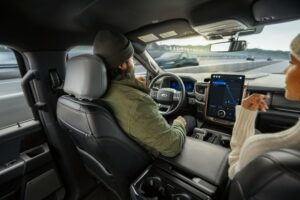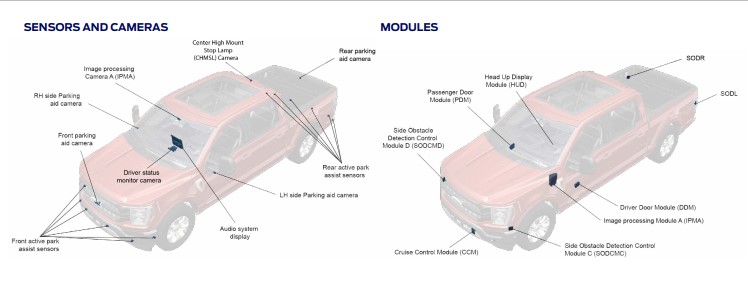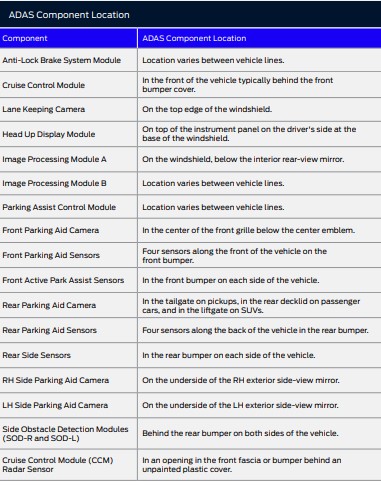
Ford shares new info on ADAS, emergency response, and BlueCruise
By onCollision Repair
Ford has shared information to help educate repairers on its Mach-E emergency response guide (ERG) and advanced driver assistance system (ADAS) component locations.
It did so through the most recent edition of its “On Target” newsletter, which also includes information about its new BlueCruise system.
Meanwhile, the next episode of I-CAR’s Repairers Realm live web series will feature the organization’s subject matter efforts which will continue their coverage of Ford’s structural sectioning guidelines.
The session will focus on sectioning the aluminum inner rocker panel of Ford and Lincoln vehicles when the running board mounting locations are damaged from a collision.
Those interested in registering for the segment, happening Wednesday at 12 p.m. CST, can do so online.
ADAS components
Using its current Ford-150 model as an example, On Target detailed the specific locations of ADAS components for reference and to aid repairers.

On Target noted that the information shared is for reference only and that when servicing or calibrating any ADAS equipment, repairers should refer to the Ford Workshop Manual available online.

ERG guidance
As it relates to the ERG, the guide is mainly intended for emergency crews and first responders, although it could also prove valuable for “second responders” like tow truck recovery operators.
“The guide contains special consideration for the high-voltage electric system components, which will allow a response to emergencies involving these vehicles to be as safe as those involving non-electric vehicles,” Ford said in On Target. “Electric vehicles (EVs) have been designed with many safety features for your protection, helping to provide safe access to the vehicle under various conditions.”
It noted that before approaching an EV that’s on fire, or in rescue or recovery situations, repairers should assume the vehicle’s high-voltage system is on and ensure power supplies are disconnected.
Failure to do so, it said, could lead to injury or death.
“Removing the service disconnect plug will disconnect the high voltage from the vehicle, however, the high-voltage battery pack will remain live and dangerous,” Ford wrote. “Do not cut or penetrate the high-voltage battery case. If possible, isolate and avoid contact with high-voltage vehicle components.”
It added that technicians should follow its warnings and service instructions thoroughly, including when depowering the system, to prevent the risk of high-voltage shock.
Its high-voltage system uses more than 450 volts of direct current provided through cables to components and modules. These high-voltage cables and wiring are identified by orange coverings or harness tape, and all high-voltage parts are marked with warning labels featuring a high-voltage symbol, the OEM said.
It added that anytime the ignition is in the off position and the vehicle is not being charged, and whenever the service disconnect plug is removed, it means the high-voltage system is deactivated.
On Target also shared two methods for high-voltage system de-energizing. The first involves confirming the vehicle is in the park position and ensuring the vehicle’s “ready” light is off to confirm the high-voltage system is disconnected. If the light is on, repairers should press the engine’s start/stop button to turn off the ignition, it said.
For the second method, Ford noted that “the high-voltage battery system uses a low-voltage disconnect plug that opens the 12-volt contactor control supply circuit.”
“It is located in the engine compartment,” Ford wrote. “When the service disconnect plug is disconnected, the high-voltage contactors that supply high voltage to the vehicle are unable to close.”
Steps for remedying that situation include:
-
- Opening the hood; detaching the retainers and removing the left-hand cover;
- Releasing the connector position assurance clip;
- “[Pressing] the tab while pulling the connector until the hole is completely visible on the top of the connector. Pull the upper part upwards until the OFF writing is visible. It is not possible to remove the sliding part of the header;” and
- Inserting a “suitable tool into the lock” to prevent reinsertion.
As the high-voltage system could remain dangerous after it is depowered, Ford recommends waiting five minutes for the voltage to dissipate.
Ford’s ERG, which can be found online, includes information on Ford’s EV and hybrid vehicles.
Other OEMs have also highlighted the importance of EV safety training. Last year, General Motors launched an EV First Responder Training program to expand its efforts educating public safety, fire, and emergency service providers in the U.S. and Canada on electric vehicle EV safety.
BlueCruise
The On Target edition also shared more information about Ford’s BlueCruise hands-free highway system which is compatible with certain sections of divided highways called Hands-Free Blue Zones.
In Ford’s workshop manual, available online, BlueCruise is referred to as Active Drive Assist with Intelligent Adaptive Cruise Control (ACC).
“The vehicle owner’s guide contains important information on the ACC system, including complete illustrations and graphic displays on control indicators and numerous warnings that need to be reviewed and followed,” Ford said in On Target. “Based on vehicle options and availability, Intelligent ACC can contain several features.”
Features might include lane centering, stop-and-go, speed sign recognition with navigation, and highway assist, it said.
Another option is the intelligent speed limited feature, which lets the driver set a speed that the vehicle can not exceed during normal driving conditions. It works in tandem with speed limits detected by ACC’s traffic sign recognition system, and sometimes the navigation system data, to set temporary caps when in certain zones.
Also available is a stop-and-go ACC feature that uses radar and camera sensors to maintain gaps between vehicles.
“Stop-and-go is set to follow the vehicle directly in front of the vehicle being driven and adjust the set speed,” Ford said in On Target. “If the vehicle that is being followed comes to a complete stop, the vehicle that is being driven also comes to a complete stop.”
More information about BlueCruise is expected to be released in future volumes.
Images
Featured image: Ford’s BlueCruise system/Courtesy of Ford
Graphics courtesy of Ford
